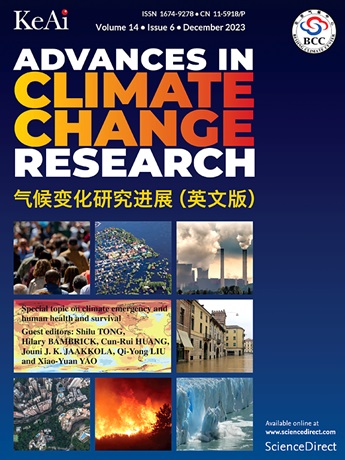A new approach for evaluating regional permafrost changes: A case study in the Hoh Xil on the interior Qinghai‒Tibet Plateau
IF 6.4
1区 地球科学
Q1 ENVIRONMENTAL SCIENCES
引用次数: 0
Abstract
The current spatial atmospheric forcing data cannot accurately depict the actual conditions of the Qinghai–Tibet Plateau (QTP), where monitoring stations are scarce and unevenly distributed. This deficiency in atmospheric data hinders accurate simulation of plateau permafrost changes on the plateau. In this study, we develop a new approach to evaluate regional permafrost changes, which does not rely on spatially distributed meteorological data but instead uses the regional climate change processes or temperature change rates. Centred on a transient heat conduction permafrost model, this approach was applied to the Qinghai Hoh Xil National Nature Reserve (referred to as Hoh Xil) within the QTP from 1960 to 2015, using the rate of air temperature change provided by the Wudaoliang Meteorological Station, the only national station in Hoh Xil. Simulation results showed that the difference between the simulated and observed change rates of mean annual ground temperature (MAGT) was less than 0.04 °C per decade from 2001 to 2015 at five long-term monitoring sites. The simulated ground temperature profiles in four boreholes from various permafrost zones revealed an error of less than 0.7 °C below 5 m in depth. Model validation demonstrates the reliability of this approach for predicting long-term permafrost changes. Future regional permafrost changes were further simulated based on the latest warming scenarios (BCC-CSM2-MR) from the Coupled Model Intercomparison Project Phase 6. Predictions revealed significant differences in the regional permafrost degradation rate under different climate warming scenarios. Under the most severe warming scenario (SSP5-8.5), permafrost in the study area is projected to still cover 72.2% of the total area by 2100, with most of the Hoh Xil's permafrost becoming warm (MAGT > −1 °C) permafrost. This approach not only facilitates the simulation of frozen ground changes in areas with few meteorological monitoring stations but also provides a new perspective for using coarse-resolution palaeoclimate data to investigate permafrost formation and evolution over long time scales.
区域冻土变化评价新方法——以青藏高原内部可可西里为例
目前的空间大气强迫数据不能准确地描述青藏高原的实际情况,该地区监测站稀少且分布不均匀。大气数据的这一缺陷阻碍了对高原冻土变化的精确模拟。在本研究中,我们开发了一种新的评估区域多年冻土变化的方法,该方法不依赖于空间分布的气象数据,而是使用区域气候变化过程或温度变化率。该方法以瞬态热传导多年冻土模型为中心,利用五道梁气象站(可可西里唯一的国家级气象站)提供的气温变化率,应用于1960 - 2015年青海可可西里国家级自然保护区(简称可可西里)。模拟结果表明,2001 - 2015年5个长期监测点的年平均地温(MAGT)变化率与观测值的差异小于0.04°C / a。在不同冻土带的4个钻孔中模拟的地温剖面显示,深度在5 m以下的误差小于0.7°C。模型验证证明了这种方法预测长期冻土变化的可靠性。基于耦合模式比对项目第6阶段的最新变暖情景(BCC-CSM2-MR),进一步模拟了未来区域永久冻土的变化。预测结果显示,不同气候变暖情景下,区域永久冻土退化率存在显著差异。在最严重的变暖情景下(SSP5-8.5),预计到2100年,研究区多年冻土仍将覆盖总面积的72.2%,可可西里的大部分永久冻土将变暖(MAGT >;−1°C)冻土。该方法不仅有利于在气象监测站较少的地区模拟冻土变化,而且为利用粗分辨率古气候数据研究长时间尺度冻土的形成和演化提供了新的视角。
本文章由计算机程序翻译,如有差异,请以英文原文为准。
求助全文
约1分钟内获得全文
求助全文
来源期刊

Advances in Climate Change Research
Earth and Planetary Sciences-Atmospheric Science
CiteScore
9.80
自引率
4.10%
发文量
424
审稿时长
107 days
期刊介绍:
Advances in Climate Change Research publishes scientific research and analyses on climate change and the interactions of climate change with society. This journal encompasses basic science and economic, social, and policy research, including studies on mitigation and adaptation to climate change.
Advances in Climate Change Research attempts to promote research in climate change and provide an impetus for the application of research achievements in numerous aspects, such as socioeconomic sustainable development, responses to the adaptation and mitigation of climate change, diplomatic negotiations of climate and environment policies, and the protection and exploitation of natural resources.
 求助内容:
求助内容: 应助结果提醒方式:
应助结果提醒方式:


